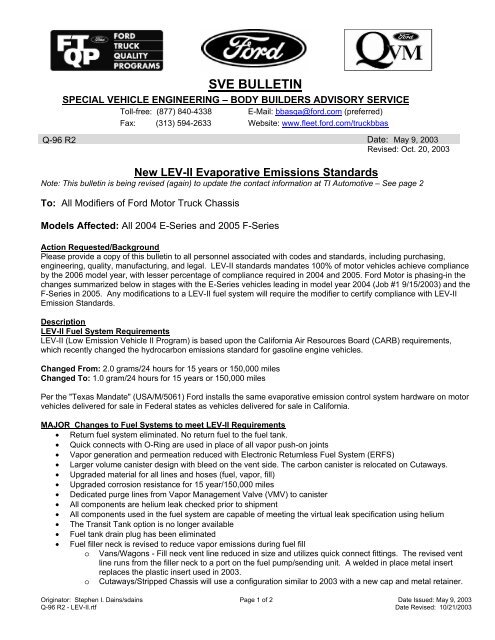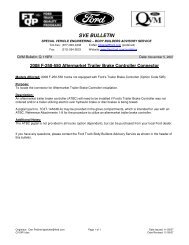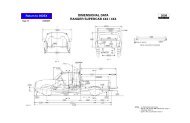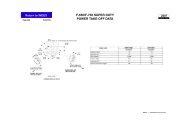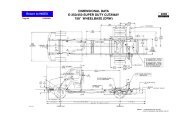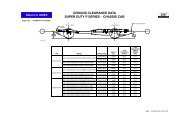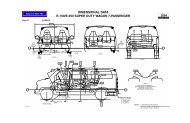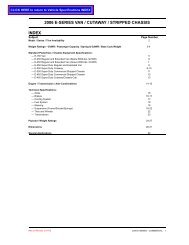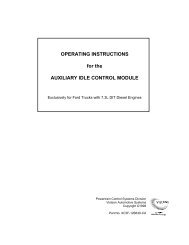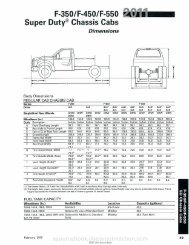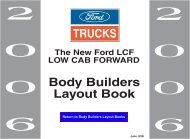SVE BULLETIN - Ford Fleet
SVE BULLETIN - Ford Fleet
SVE BULLETIN - Ford Fleet
Create successful ePaper yourself
Turn your PDF publications into a flip-book with our unique Google optimized e-Paper software.
<strong>SVE</strong> <strong>BULLETIN</strong><br />
SPECIAL VEHICLE ENGINEERING – BODY BUILDERS ADVISORY SERVICE<br />
Toll-free: (877) 840-4338 E-Mail: bbasqa@ford.com (preferred)<br />
Fax: (313) 594-2633 Website: www.fleet.ford.com/truckbbas<br />
Q-96 R2 Date: May 9, 2003<br />
Revised: Oct. 20, 2003<br />
New LEV-II Evaporative Emissions Standards<br />
Note: This bulletin is being revised (again) to update the contact information at TI Automotive – See page 2<br />
To: All Modifiers of <strong>Ford</strong> Motor Truck Chassis<br />
Models Affected: All 2004 E-Series and 2005 F-Series<br />
Action Requested/Background<br />
Please provide a copy of this bulletin to all personnel associated with codes and standards, including purchasing,<br />
engineering, quality, manufacturing, and legal. LEV-II standards mandates 100% of motor vehicles achieve compliance<br />
by the 2006 model year, with lesser percentage of compliance required in 2004 and 2005. <strong>Ford</strong> Motor is phasing-in the<br />
changes summarized below in stages with the E-Series vehicles leading in model year 2004 (Job #1 9/15/2003) and the<br />
F-Series in 2005. Any modifications to a LEV-II fuel system will require the modifier to certify compliance with LEV-II<br />
Emission Standards.<br />
Description<br />
LEV-II Fuel System Requirements<br />
LEV-II (Low Emission Vehicle II Program) is based upon the California Air Resources Board (CARB) requirements,<br />
which recently changed the hydrocarbon emissions standard for gasoline engine vehicles.<br />
Changed From: 2.0 grams/24 hours for 15 years or 150,000 miles<br />
Changed To: 1.0 gram/24 hours for 15 years or 150,000 miles<br />
Per the "Texas Mandate" (USA/M/5061) <strong>Ford</strong> installs the same evaporative emission control system hardware on motor<br />
vehicles delivered for sale in Federal states as vehicles delivered for sale in California.<br />
MAJOR Changes to Fuel Systems to meet LEV-II Requirements<br />
• Return fuel system eliminated. No return fuel to the fuel tank.<br />
• Quick connects with O-Ring are used in place of all vapor push-on joints<br />
• Vapor generation and permeation reduced with Electronic Returnless Fuel System (ERFS)<br />
• Larger volume canister design with bleed on the vent side. The carbon canister is relocated on Cutaways.<br />
• Upgraded material for all lines and hoses (fuel, vapor, fill)<br />
• Upgraded corrosion resistance for 15 year/150,000 miles<br />
• Dedicated purge lines from Vapor Management Valve (VMV) to canister<br />
• All components are helium leak checked prior to shipment<br />
• All components used in the fuel system are capable of meeting the virtual leak specification using helium<br />
• The Transit Tank option is no longer available<br />
• Fuel tank drain plug has been eliminated<br />
• Fuel filler neck is revised to reduce vapor emissions during fuel fill<br />
o Vans/Wagons - Fill neck vent line reduced in size and utilizes quick connect fittings. The revised vent<br />
line runs from the filler neck to a port on the fuel pump/sending unit. A welded in place metal insert<br />
replaces the plastic insert used in 2003.<br />
o Cutaways/Stripped Chassis will use a configuration similar to 2003 with a new cap and metal retainer.<br />
Originator: Stephen I. Dains/sdains Page 1 of 2 Date Issued: May 9, 2003<br />
Q-96 R2 - LEV-II.rtf Date Revised: 10/21/2003
DURABILITY of Evaporative System<br />
<strong>Ford</strong> will be required to honor the CARB regulations of 15-year/150,000 mile LEV-II emission requirements in California,<br />
and also in “Section 177” states that have adopted California’s regulations as allowed by Clean Air Act (CAA). The fuel<br />
system will be required to remain functional for at least 15 years/150,000 miles. This includes integrity against liquid or<br />
vapor leak, no increase in permeation above the normal, stabilized level, and no increase in breathing losses from the<br />
canister or air induction system.<br />
TESTING<br />
<strong>Ford</strong> automotive designs are validated for extended time by certain tests that accelerate the various wear and<br />
deterioration phenomena. These tests are conducted at several levels:<br />
1. Vehicle – Certified to Government requirements<br />
2. System – Fuel permeation rig test (20-40 week tests to ensure system has reached stabilization)<br />
3. Subsystem – Supplier tests mating components to ensure no HC permeates through interfaces.<br />
4. Components – 100% leak check<br />
5. Materials – All fuel related material is tested to ensure compliance with LEV-II requirements<br />
6. Mating Surfaces – Dimensional tolerances are designed so the component/subassembly will pass the Virtual<br />
Leak Detection (VLD) specifications as long as it is within tolerance. Where the two mating surfaces are<br />
"owned" by different suppliers, both suppliers are required to independently verify the connection passes VLD<br />
requirements through the tolerance range, over the CARB temperature profile.<br />
7. Leak Testing - All assemblies 100% helium leak checked before delivery to <strong>Ford</strong>’s final assembly plant<br />
Body Builder Recommendations:<br />
Fuel Fill Modifications<br />
The E-Series Cutaway/Stripped Chassis will continue to provide extended length of fuel filler hose and vent line.<br />
Builders using <strong>Ford</strong> provided materials and installation recommendations can assume LEV-II compliance. Any non-<strong>Ford</strong><br />
components will require the modifier to certify compliance with LEV-II emission standards.<br />
Fuel Lines/Vent Lines<br />
All fuel/vent lines should be OE quality and utilize double O-ring connectors. Fuel lines should meet OE permeability<br />
specifications.<br />
Carbon Canister Relocation<br />
Carbon Canister and fuel tank vent lines are part of the LEV-II fuel system. The final stage manufacturer is responsible<br />
to certify any modification made to the fuel system for LEV-II compliance.<br />
LEV-II Supplier Contacts/Web Addresses<br />
The following companies can provide products or services to assist builders that modify fuel system components.<br />
Fuel Filler Neck Fuel Line/Vapor Line Extensions Fuel System/Component Testing<br />
Shelby Enterprises, Inc. TI Automotive TSG Testing Services Group<br />
Jennifer Dedenbach George Manolias Doug Hughes<br />
596-752-4552, Ext 234 586-755-8313 810-245-1600<br />
www.shelbyenterprises.com gmanolias@us.tiauto.com www.tsglabs.com<br />
Note: All QVM Bulletins, <strong>Ford</strong> Truck Quality Program Guidelines, Body Builders Layout Book, Incomplete Vehicle<br />
Manual (IVM) and other builder data is available at www.fleet.ford.com/truckbbas. Since the California Air Resources<br />
Board is the source of the LEV-II regulations, questions concerning compliance should be addressed to them. Their<br />
web address is www.arb.ca.gov.<br />
Sincerely,<br />
D. J. Snyder<br />
Modified Vehicle Engineering Quality Programs<br />
Originator: Stephen I. Dains/sdains Page 2 of 2 Date Issued: May 9, 2003<br />
Q-96 R2 - LEV-II.rtf Date Revised: 10/21/2003


